Pictures of newly discovered species in Borneo
Pictures of newly discovered species in Borneo
More than 400 species discovered on island rainforest since 1994
mongabay.com
December 19, 2006
Yesterday’s announcement by WWF that 52 previously unknown species were discovered in the fast-disappearing rainforests of Borneo brings the total number of “new” species found on the island to more than 400 since 1994.
WWF is using the discoveries to bolster support for its “Heart of Borneo” initiative which seeks to conserve 84,000 square miles (220,000 square kilometers) of mountainous rainforest in the center of the island.
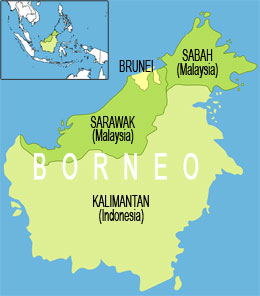 Map by Rhett A. Butler, mongabay.com. Recent discoveries in Borneo include what is believed to be the world’s largest cockroach at 10 cm (4 in) long. The beast was discovered in 2004 in a limstone cave. |
“The more we look the more we find,” said Stuart Chapman, WWF International Coordinator of the Heart of Borneo Program. “These discoveries reaffirm Borneo’s position as one of the most important centers of biodiversity in the world and why conservation there is so important.”
“The remote and inaccessible forests in the Heart of Borneo are one of the world’s final frontiers for science,” said Adam Tomasek, director of WWF-US’s Borneo & Sumatra Program. “Certainly, many new species are yet to be discovered there. These forests are also vital because they are the source of most of the island’s major rivers, and provide life sustaining freshwater and other ecosystem services.”
The latest discoveries include 30 fish species, two tree frog species, 16 ginger species, three tree species and one large-leafed plant species. Still little is known about most of these species, though WWF gives a brief descriptions of the finds:
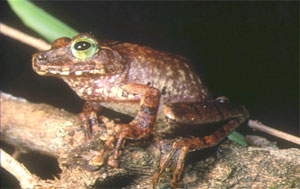 Polypedates chlorophthalmus tree frog (© Indraneil Das) 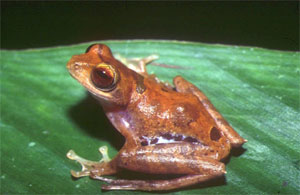 Rhacophorus gadingensis tree frog (© Indraneil Das) 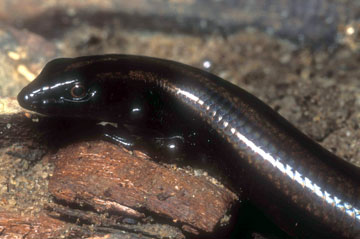 The newly discovered lizard, a type of skink, from Borneo. (© Chris Austin) 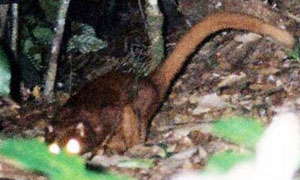 Mysterious animal caught by a camera trap but unidentified (© Stephan Wulffraa) 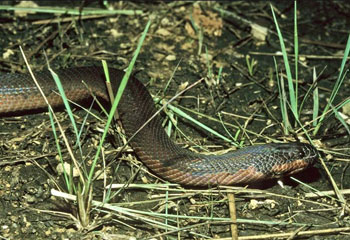 The Kapuas mud snake Enhydris gyii, recently discovered in Kalimantan. (© Mark Auliya)  Paedocypris progenetica, the world’s smallest known freshwater fish was found in Sumatra. A closely related species was discovered in the pat swamps of Borneo (© Maurice Kottelat) |
“Many of these creatures new to science are amazing: a miniature fish — the world’s second smallest vertebrate, measuring less than one centimetre in length and found in the highly acidic blackwater peat swamps of the island; six Siamese fighting fish, including one species with a beautiful iridescent blue-green marking; a catfish with protruding teeth and an adhesive belly which allows it to literally stick to rocks; and a tree frog with striking bright green eyes.”
Since 1980 Borneo’s forests have been destroyed at a rate unparalleled in human history. Its rain forests went to industrialized countries like Japan and the United States in the form of garden furniture, paper pulp and chopsticks. Initially most of the timber was taken from the Malaysian part of the island in the northern states of Sabah and Sarawak. Later, forests in the southern part of Borneo, an area belonging to Indonesia and known as Kalimantan, became the primary source for tropical timber.
Today less than half of the island’s original rainforest remains and this is fast-declining due to logging and fires set for land clearing. Once verdant forest is giving way to rows of oil palm trees which are used to produce biofuels and household oil products.
The ongoing destruction has spurred WWF to lanuch a major conservation plan for the island’s remaining forests. Last March, Brunei Darussalam, Indonesia and Malaysia agreed to support a WWF initiative to conserve and sustainably manage the Heart of Borneo. In July of this year, the United States also lent support to the initiative.
Read the full study [.doc]
Articles on species discovery in Borneo
- Unknown species of lizard discovered in Borneo
- New fox species discovered in jungle of Borneo
- Borneo’s forests disappear while 361 animal species discovered
- Color-changing chameleon snake discovered in jungles of Borneo
- Picture of the world’s smallest fish
- In search of Bigfoot, scientists may uncover unknown biodiversity in Malaysia
- Pictures of the Borneo rainforest
Borneo articles
Species discovery articles